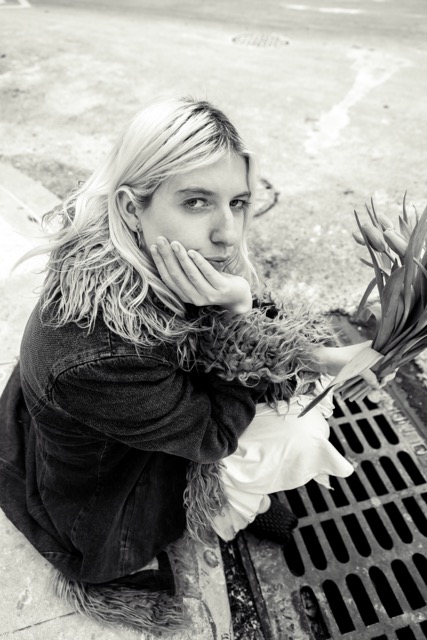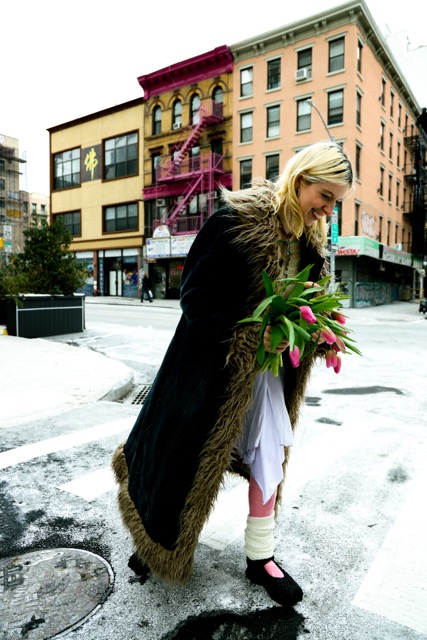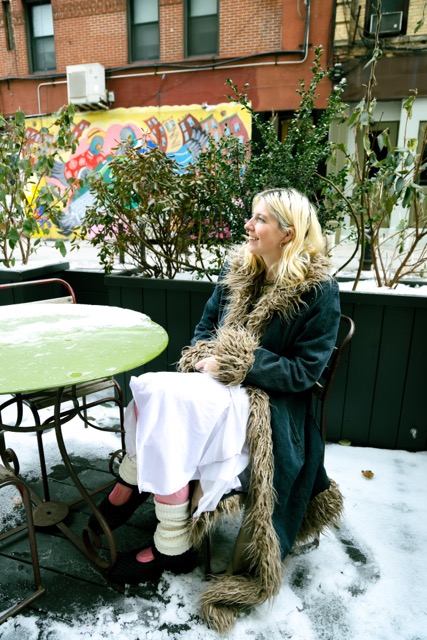TYLER MCGILLIVARY

Fashion Designer
Published February 6 2024 for Issue 02. Interview by: Chandler Crump
Produced by: Daniella Bernal
Special Thanks: Casetta, NYC
Photography by: Chandler Crump
Photo Assistants: Marianna Kaimakliotis, Mel Krych
Stylist: Tyler McGillivary
CHANDLER CRUMP (CC): What is the logline to your craft?
TYLER MCGILLIVARY (TM): That's a good question. Well, I think it's changing a lot currently. I feel like [the brand’s] logline is “letting nature lead with the design”. A lot of our recent work has been focused on sourcing imagery of the planet and all of the beautiful plants and animals and creatures that exist within it, and then letting that kind of lead as a textile and building the world around that.
I think the something I've been thinking about this year is just the idea of consistent artistic change and growth, and following inspiration. Because I do think [the brand] started at one place [and] now it's different, in terms of aesthetics design.
CC: But there has been consistency with your style. I would say your instinct towards orchids, butterflies, nature and, you know, the almost,like, natural color palette of the world…there's definitely consistency.... at least from what I see.
TM: Definitely, like the day one Flower top.
CC:I know, I love the flower top


TM: I think that what has also always been something that has been so important to me is returning to that initial...almost like an impulse towards design and why I wanted to do this. I suppose because I think it is so easy to have your work blurred by a need to make money. And I need to, you know? Sustain your team and sustain yourself. Especially as I get older.
And so I think it's been important for me to like, time and again, refocus on why I'm doing this, what first resonated with people, and what first resonated with me.
CC: Is that the crafting of it all too? Like, I'm guessing that the [original] flower top was handmade.
TM: That, yeah, that was definitely handmade.
CC: Before any manufacturer, like printing anything.
TM: Yeah. 100%, and figuring out how to produce that top not handmade was such a feat and a complicated process. I think that right now, I'm in a space where I feel like I spent last year [2023] sort of setting up the business/financial aspect of the brand. I want to return to the artistic; the new design aspect of the brand, almost like in a new light. I want to spend time researching and kind of integrating the images that I have back to the designs and kind of making them more thoughtful and not so reactionary.
We started doing wholesale again, which is giving us some space to do that. But I think the key is that it always comes back to like, you know, looking at how certain imagery or elements of design can be translated into adornment.
[Regarding the Flower top]: I had never seen somebody become sort-of a human flower before we started doing that, in that sense.
CC: I remember seeing you creating these visual aesthetics back in 2018 on Instagram. Were you ever on SSENSE?
TM: We were not on SSENSE; I would love to be featured [though].
CC: There's also Café Forgot
TM: That was the first place that ever sold our stuff. And I love their work and love their support of artists. Yeah, they're great.
[My brand] used to sell other people's things, which was cool. And I want to get back into that too. But I think yeah, I've always been interested in how to create clothes that feel like that, kind of, elicit feeling that you have when you're at a vintage store and you find a special thing that you're looking for.
It's that feeling of, “My God, no one else has this!”. I think there’s always been kind of the thought of how can I make pieces that feel like that but at a relatively accessible price point. I know that accessibility is relative, but I think in comparison to a lot of the other brands that are out there, [there’s accomplishment].
CC: Tyler McGillivary is ethically sourced as well. That [in-itself] is also pioneering the fashion business model as well, you know, for future generations…
TM: Definitely, and I think it's not even a negotiation to this point. It's something that you have to do anyways. Anybody who doesn't... well, they have a very flawed system. But I think one of our big things is trying to turn over our fabrics to be predominantly recycled, which I feel could be exciting. And it's also a complicated thing, what do you do that you're also adding in pricing?
CC: I think also people are buying quality at the same time. Fast fashion has really been on the forefront and especially in 2020 and after, I don't think people realize that when you buy quality and you pay more, it will last longer so you don't have to buy anymore.
TM: There's such a need for consistency. I think people want new things constantly in terms of their wardrobe. I understand that I'm somebody who does feel like that at times, but it's a really important that those [pieces] are lasting and that you're not using them once and then throwing them away.
Also, hopefully you're able to wear that [piece] a million different ways. That's sort of like the basic log line idea: wearable art or wearable nature that feels like something that you've never seen before.
CC: And, is that your craft? Like as you, Tyler.
TM: I think as me, Tyler... I don't know. I think it's a positive thing. I think I had a really hard time for a long time, identifying myself as an artist. I grew up in a really suburban home where there's a really specific idea of what life looks like.
CC: You're from D.C. right?
TM: Yeah, I'm from the outskirts of the DMV area. I'm from Maryland actually. I think it took me a long time to realize even... and, it's still such a learning process of “What am I putting into the world?” “What do I want to be putting out to the world?” “Who is it for? Is it for that for me, or is it for our customer or is it for, you know, a specific buyer?” I think now, I'm probably at the point where I'm like, I want to make things that appeal to me.
My craft? That's a good question. I think that at the heart, I am a textile style designer and an image collector. I think that that leads to a lot of my work. And I'm also... by just growing up, I'm an illustrator. I used to want to try illustration, so I think that helps a lot.
CC: Did you major in that? I know you went to Gallatin [NYU]. And I know there's sociology within that degree.
TM: I did, yeah. I went to Gallatin. I used to do production design. So I used to hang out with all the drama people all the time. So my major or my focus in college was on how identity is constructed through dress; the ways in which we use clothing as a visual language and what that means--
CC: Like more pertinent-
TM: Totally, absolutely. I still think that that's so important. I was thinking the other day, even earlier today [while] preparing my personality outfit: “What is my personality at this point?”
I think about the idea that so many people are putting together outfits for Instagram, for TikTok and stuff. It's just for consumers. But, also, it's become this weird thing where it's, styles have become so eclectic…
It's such a hodgepodge of different influences that it’s hard to identify what personal style is. The general environment of Maryland isn't super creatively focused. Going to Gallatin allowed me to be like, “Okay, this [piece of clothing] is something that [I] can play with, like there's something…”
CC: And being in New York.
TM: That too, New York of course.
CC: I mean, I'm from San Francisco and there's no San Francisco Fashion Week. There's no Maryland Fashion Week.
TM: No, my God!
CC: So, you grew up in Maryland. Did that influence your North Star, if you had one?
TM: Totally. I think one thing was that I was bored a lot growing up and I was floating off into my imagination. And yeah, I think that allowed me to find creativity as an outlet and always center art in my life and focus on finding peace through that. Boredom I think is so important. And that's something that I've been thinking about a lot recently, especially because there's just a lot of that in our world.
CC: Yeah, and imagination.
TM: Like, escaping before iPhones. You know, being in class and/or being in you're very... you know, that beige home… you can't imagine.
CC: “What do I want to wear? What do I want to be??
TM: Yeah, I think [boredom and imagination] is so important. I wonder how different my life would have looked if I was so stimulated in, like, a creative, interesting way when I was younger. I don't know what that would have done creatively… Also, I went to a really rigorous high school with all girls.
CC: Did you guys have uniforms? I went to an all-girls K-8. We all looked like Sailor Moon. Our only accessory we could have were the hair scrunchies or the pencil cases.
TM: That was the same. Also, I think just the environment of focused on ambition, of doing well and, you know, progressing…
CC: The Gossip Girl era.
TM: Yeah, exactly! I’m constantly being like “Okay, this isn't good enough”, which isn't a bad thing. I've recently made peace with [how I think] about things in the sense that I never feel content as a designer. I'm always like “What's next?” “What's new, what's interesting?” Self criticism that maybe comes from a kind of a negative environment, but ultimately does force you to kind of look at the world [from] a view of progression.
CC: Yeah. I can relate very much in terms of feeling as if every single time, every single film I was making [in school], feeling like “That's not good enough” “The next one will become better”.


CC: I'm curious to know about your process: do you see an icon, a feeling, a thesis…?
TM: I start by collecting imagery, so I'll scroll Pinterest because I am a Pinterest girly. I'm also an Arena girl. I don't know if you've used it or..
CC: I have not.
TM: I feel like Pinterest is very self-curating. Arena is cool because it shows you all different images from different artists.
CC: Do you go to the Botanical gardens?
TM: Yes, I'm a huge botanical garden fan. I love the one in the Bronx. I go there like at least three or four times a year, definitely for the orchid show.
CC: I'm guessing you're not allergic to flowers.
TM: No.

CC: Would you ever open your own store?
TM: Store? Definitely. I definitely want to do that. I think that right now, our hope is to integrate other artists’ work on our site again. So kind of build out the online store version of that, and add in an actual storefront.
It's one of those stories [where] I'm like, I can never tell how successful people actually are in regards to their storefront. I've heard a lot it's mostly a marketing thing. Like you're just looking at it as like a marketing budget. But I know that a lot of stores around [the Lower East Side] do super well, so I'm definitely interested.
I think it would be cool where the front is the store, the back is a studio.
CC: Yeah. A café. Like juice or something.
TM: That would be so nice. A wine bar is really fun.


CC: In terms of monetization and setting up your shop, the website and just like taking [that] step, then I'm guessing stockists and then material quality…How? What was your approach?
TM: I basically just taught myself so many things and I started by selling everything myself.
I had a friend who has a business and she was like, “I will help you figure out how to do production stuff”. [I took photos for her]. And so she helped me so much.
I would go find tech materials that are like going to sample the product.I had no idea about fabrics. I worked for a designer all through college, which was super helpful. So I kind of had an idea of the way things worked. You had to get a showroom representative and you had to get stores to buy stuff, to make money, to then make more production…But I was like, I don't know anything about sewing structure. So, the first season…the first season it was okay. It was not great. We did sell to Urban Outfitters.
.
.
.
CC: How did the [recent] holiday capsule come alive?
TM: I sourced this dress that my sister in law has, this gorgeous vintage French red dress. That was the inspiration around it. It's really long, all these roses in the color. But it's so funny, everyone's part of the same inspiration. [2023] was roses and bows.
CC: Roses and the bows.

Be Mine Dress - Tyler McGillivary
CC: Do you have an upcoming collection coming out for the spring [2024]?
TM: Yeah!



CC: They're absolutely gorgeous.
TM: That's coming in March. We have a lot of fruits and Lillies.
CC: What's the name for this collection?
TM: Candyland. Juicy, fun, alot of lilies and then a lot of fruit. What I imagine wearing as a cartoon character.
CC: Those are gorgeous. And I feel like every single piece I've seen, like the color and saturation that you're able to [achieve] is such great quality.

CC: If you had unlimited funding, how would you use it?
TM: Unlimited funding. My God, I would hire a business manager… like a really good business manager. I would do that, and I would hire a bookkeeper. And then I would probably hire the best talent and give [everyone] raises and myself a raise… and then if I just continue with unlimited funding, I would definitely buy a combined apartment studio.
CC: Beautiful.
.
.
.
CC: What do you wear for the craft?
TM: I am a big T-shirt and big jeans, like big cargo pants and T-shirt, person. When I go to the studio, I like to be comfortable. [No distractions!]


CC: Des vêtements avec vérité? Favorite pieces you’re enjoying right now?
TM: Okay, I've been really into the Mother God docuseries – it's so crazy, the followers have this weird sort of commercial-hippie style that I like… I think it's more like if a nineties raver [was] doing seventies hippie.
[Also] Medieval fairy folklore. I love my tutu that I'm wearing right now.
Fin

